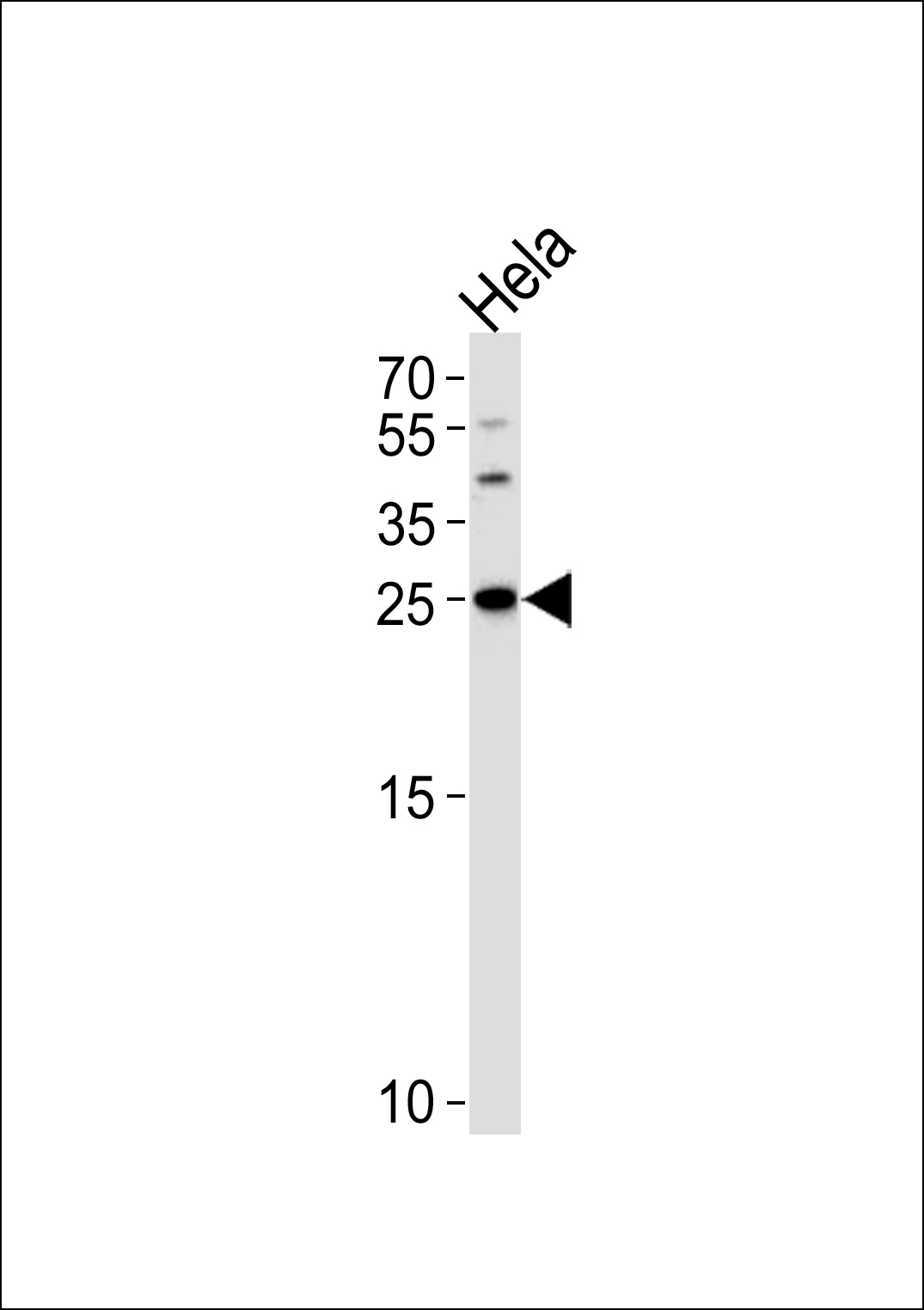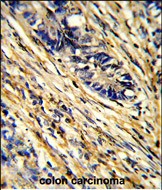YWHAG Antibody (Center)
Purified Rabbit Polyclonal Antibody (Pab)
- SPECIFICATION
- CITATIONS
- PROTOCOLS
- BACKGROUND

Application
| WB, FC, IHC-P, E |
|---|---|
| Primary Accession | P61981 |
| Other Accession | Q6NRY9, Q6PCG0, P61983, P61982, Q5F3W6, P68252, P68253 |
| Reactivity | Human, Mouse |
| Predicted | Bovine, Chicken, Rat, Sheep, Xenopus |
| Host | Rabbit |
| Clonality | Polyclonal |
| Isotype | Rabbit IgG |
| Calculated MW | 28303 Da |
| Antigen Region | 136-164 aa |
| Gene ID | 7532 |
|---|---|
| Other Names | 14-3-3 protein gamma, Protein kinase C inhibitor protein 1, KCIP-1, 14-3-3 protein gamma, N-terminally processed, YWHAG |
| Target/Specificity | This YWHAG antibody is generated from rabbits immunized with a KLH conjugated synthetic peptide between 136-164 amino acids from the Central region of human YWHAG. |
| Dilution | WB~~1:1000 IHC-P~~1:50~100 FC~~1:10~50 |
| Format | Purified polyclonal antibody supplied in PBS with 0.09% (W/V) sodium azide. This antibody is prepared by Saturated Ammonium Sulfate (SAS) precipitation followed by dialysis against PBS. |
| Storage | Maintain refrigerated at 2-8°C for up to 2 weeks. For long term storage store at -20°C in small aliquots to prevent freeze-thaw cycles. |
| Precautions | YWHAG Antibody (Center) is for research use only and not for use in diagnostic or therapeutic procedures. |
| Name | YWHAG (HGNC:12852) |
|---|---|
| Function | Adapter protein implicated in the regulation of a large spectrum of both general and specialized signaling pathways (PubMed:15696159, PubMed:16511572, PubMed:36732624). Binds to a large number of partners, usually by recognition of a phosphoserine or phosphothreonine motif (PubMed:15696159, PubMed:16511572, PubMed:36732624). Binding generally results in the modulation of the activity of the binding partner (PubMed:16511572). Promotes inactivation of WDR24 component of the GATOR2 complex by binding to phosphorylated WDR24 (PubMed:36732624). Participates in the positive regulation of NMDA glutamate receptor activity by promoting the L- glutamate secretion through interaction with BEST1 (PubMed:29121962). Reduces keratinocyte intercellular adhesion, via interacting with PKP1 and sequestering it in the cytoplasm, thereby reducing its incorporation into desmosomes (PubMed:29678907). Plays a role in mitochondrial protein catabolic process (also named MALM) that promotes the degradation of damaged proteins inside mitochondria (PubMed:22532927). |
| Cellular Location | Cytoplasm, cytosol. Mitochondrion matrix. Note=Translocates to the mitochondrial matrix following induction of MALM (mitochondrial protein catabolic process). |
| Tissue Location | Highly expressed in brain, skeletal muscle, and heart. |
If you have used an Abcepta product and would like to share how it has performed, please click on the "Submit Review" button and provide the requested information. Our staff will examine and post your review and contact you if needed.
If you have any additional inquiries please email technical services at tech@abcepta.com.














 Foundational characteristics of cancer include proliferation, angiogenesis, migration, evasion of apoptosis, and cellular immortality. Find key markers for these cellular processes and antibodies to detect them.
Foundational characteristics of cancer include proliferation, angiogenesis, migration, evasion of apoptosis, and cellular immortality. Find key markers for these cellular processes and antibodies to detect them. The SUMOplot™ Analysis Program predicts and scores sumoylation sites in your protein. SUMOylation is a post-translational modification involved in various cellular processes, such as nuclear-cytosolic transport, transcriptional regulation, apoptosis, protein stability, response to stress, and progression through the cell cycle.
The SUMOplot™ Analysis Program predicts and scores sumoylation sites in your protein. SUMOylation is a post-translational modification involved in various cellular processes, such as nuclear-cytosolic transport, transcriptional regulation, apoptosis, protein stability, response to stress, and progression through the cell cycle. The Autophagy Receptor Motif Plotter predicts and scores autophagy receptor binding sites in your protein. Identifying proteins connected to this pathway is critical to understanding the role of autophagy in physiological as well as pathological processes such as development, differentiation, neurodegenerative diseases, stress, infection, and cancer.
The Autophagy Receptor Motif Plotter predicts and scores autophagy receptor binding sites in your protein. Identifying proteins connected to this pathway is critical to understanding the role of autophagy in physiological as well as pathological processes such as development, differentiation, neurodegenerative diseases, stress, infection, and cancer.






